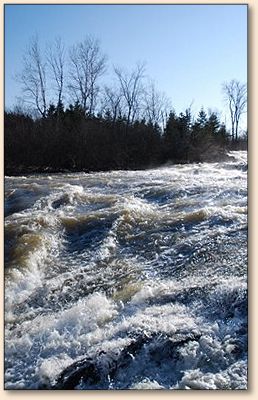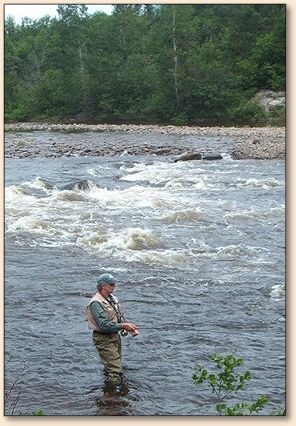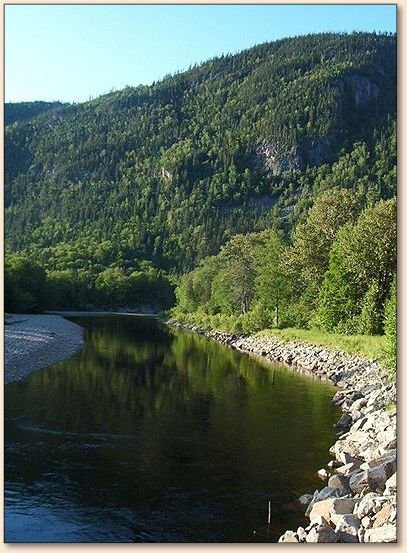Reading the Water - Part 4
(Rapids, Runs and Slicks)
By Chris Chin
 A final little blurb about different types of water. These types of
water are particularly dear to me as they are also holding water
for the Atlantic salmon which I fish for on my home waters.
A final little blurb about different types of water. These types of
water are particularly dear to me as they are also holding water
for the Atlantic salmon which I fish for on my home waters.
Depending on who you talk to and where your home waters are,
rapids can be quite different.
Rapids are for me, stretches of fast moving water where obstacles
(boulders) and holes make a pronounced hydraulic. This means
that the depth can vary from a couple of feet right down to 10-15
feet, depending on the volume of water, the flow rate and the size
of the obstacles.
On the right, we see the rapids just upstream from my house.
Obviously, there aren't very many holding lies in this rapid.
Below, see our very own Jed on the #39.

Rapids are usually holding water. A trout can hole up in a hydraulic.
He has cover from predation because of the broken surface. This
type of water isn't very good "bug" habitat though, so food isn't
readily available. A trout holding in a rapid is opportunistic, waiting
for a snack to whisk by. For us anglers, this is a good thing, because
the trout will be more willing to take with abandon. He doesn't have
the leisure nor time to inspect an offering. He has to dart from cover,
take and get back to his lie. Classic take 'n turn.
Fishing rapids means presenting on, below, around and above obstacles.
I'll often do 3-4 presentations to each potential lie. It is always amazing
for me, the ability of a trout or salmon to hold on hydraulic effects
UPSTREAM from an obstacle. It wasn't until some friends (white water
kayakers) explained to me that there is a bow wave effect upstream of big
obstacles, that I started to cast to the leading edge of obstacles.
When a rapid widens out, the water flow rate will diminish and the
depth will come up a bit. This is what I call a run. In reality, I
suppose a run is just a gentle rapid. I make the distinction
because on salmon rivers, we seem to get picky about vocabulary.
Once a river flows out of a rapid and into a run, (IMHO), chances
improve for fishing. There are more holding, feeding as well as prime
lies. The slower current affords more living space or "bugs." We
have more success in runs as well, because we fish them more often.
Wading is easier, we don't need a drift boat.

The run leading down to the #25 on my home waters
If I had to really put it to words, I suppose a run is between a
rapid and a riffle. The water still has a broken surface belying
subsurface obstacles and depressions. Good for us. We can
easily see where potential holding lies are. The river bed is
more rocks and small boulders than sand and gravel. Techniques
and tactics in runs are the same as in rapids, except everything
slows down a bit. I use smaller flies, slower drifts and lighter
leaders. My big "indicator" dries yield to smaller Red Tags and
Wulffs. The Muddlers move away from classic and over to
Rabbit strip muddlers.
Because I pretty well only fish for Atlantic salmon and
sea run trout, I spend half of my time in runs and the
other half in pools and slicks.
What's a slick?

The #36 – St-Marguerite River Quebec
Slicks are smooth surfaced sections of moving water. For
a trout angler, slicks are usually barren grounds. They afford
little cover, few "bugs" and few hydraulics to help hold station.
I am often amazed to see anglers casting to "dead water."
From a short distance, a slick may look like a hole of holding
water. On many occasions, I have explored waters only to
eventually realize that the nice spot I was casting to was actually
only 1 foot deep and barren.
One side note about slicks: Atlantic salmon have some weird
behaviour. They will hole up where they have the best
combination of flow, hydraulics, cover and cool water. We
often find salmon in slicks. (Here's a secret: the Ste-Marguerite
has many fresh water springs in the river bed. Salmon will sit
on these sources of cool water, even if it's in the middle of a slick).
Rapids and runs are fabulous places to fish. IMHO, fly fishing
was made for these waters. Precision presentations, dry flies
and reel screaming runs in the current! ~ Chris Chin, St-Severin de Proulxville, Quebec.
About Chris:
Chris Chin is originally from Kamloops,
British Columbia. He has been fly fishing
on and off ever since he was 10 years old.
Chris became serious about the sport within
the last 10 years.
"I'm a forest engineer by day and part time
guide on the Ste-Marguerite River here in
central Quebec. I've been fishing this river
for about 10 years now and started guiding
about 5 years ago when the local guide's
association sort of stopped functioning."
Chris guides mostly for sea run brook trout
and about 30% of the time for Atlantic Salmon.
"I often don't even charge service fees, as
I'm more interested in promoting the river
than making cash. I like to get new comers
to realize that salmon fishing is REALLY for
anyone who cares to try it. Tradition around
here makes some of the old clan see Salmon
fishing as a sport for the rich. Today our
shore lunches are less on the cucumber sandwich
side and more toward chicken pot pie and Jack
Daniel's."
Chris is 44 years old as of this writing. He
is of Chinese origin although his parents were
born and raised in Jamaica.
To learn more about the Ste-Marguerite River,
visit Christopher's
website. You can email Chis at: Flyfishing.christopher@gmail.com.
Our Man In Canada Archives
|

